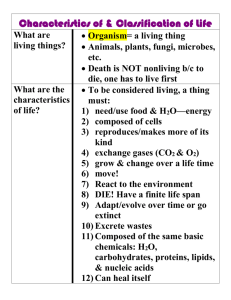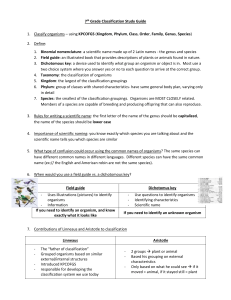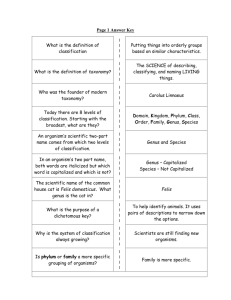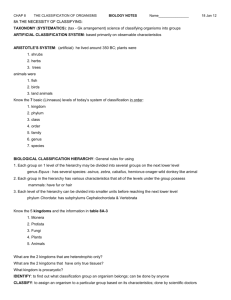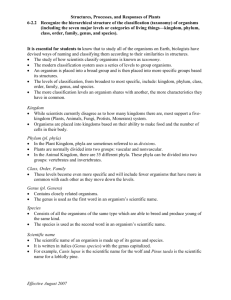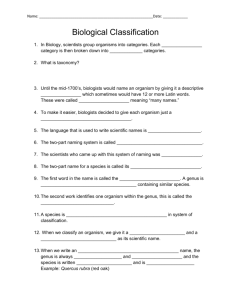CHAPTER 1, A VIEW OF LIFE QUIZ
advertisement
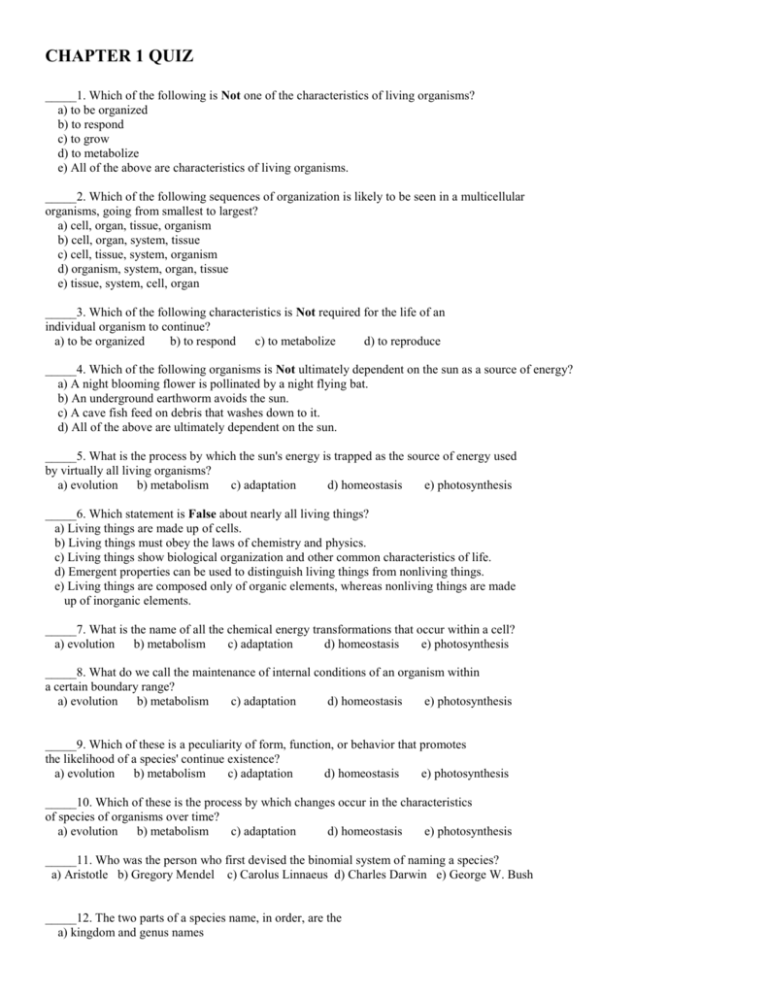
CHAPTER 1 QUIZ _____1. Which of the following is Not one of the characteristics of living organisms? a) to be organized b) to respond c) to grow d) to metabolize e) All of the above are characteristics of living organisms. _____2. Which of the following sequences of organization is likely to be seen in a multicellular organisms, going from smallest to largest? a) cell, organ, tissue, organism b) cell, organ, system, tissue c) cell, tissue, system, organism d) organism, system, organ, tissue e) tissue, system, cell, organ _____3. Which of the following characteristics is Not required for the life of an individual organism to continue? a) to be organized b) to respond c) to metabolize d) to reproduce _____4. Which of the following organisms is Not ultimately dependent on the sun as a source of energy? a) A night blooming flower is pollinated by a night flying bat. b) An underground earthworm avoids the sun. c) A cave fish feed on debris that washes down to it. d) All of the above are ultimately dependent on the sun. _____5. What is the process by which the sun's energy is trapped as the source of energy used by virtually all living organisms? a) evolution b) metabolism c) adaptation d) homeostasis e) photosynthesis _____6. Which statement is False about nearly all living things? a) Living things are made up of cells. b) Living things must obey the laws of chemistry and physics. c) Living things show biological organization and other common characteristics of life. d) Emergent properties can be used to distinguish living things from nonliving things. e) Living things are composed only of organic elements, whereas nonliving things are made up of inorganic elements. _____7. What is the name of all the chemical energy transformations that occur within a cell? a) evolution b) metabolism c) adaptation d) homeostasis e) photosynthesis _____8. What do we call the maintenance of internal conditions of an organism within a certain boundary range? a) evolution b) metabolism c) adaptation d) homeostasis e) photosynthesis _____9. Which of these is a peculiarity of form, function, or behavior that promotes the likelihood of a species' continue existence? a) evolution b) metabolism c) adaptation d) homeostasis e) photosynthesis _____10. Which of these is the process by which changes occur in the characteristics of species of organisms over time? a) evolution b) metabolism c) adaptation d) homeostasis e) photosynthesis _____11. Who was the person who first devised the binomial system of naming a species? a) Aristotle b) Gregory Mendel c) Carolus Linnaeus d) Charles Darwin e) George W. Bush _____12. The two parts of a species name, in order, are the a) kingdom and genus names b) genus and family names c) genus and specific epithet (species) d) specific epithet and genus name e) species and genus names _____13. Which of the following sequences correctly gives the different classification levels of an organism, going from the largest group to the smallest? (Some are left out.) a) species, genus, family, class, phylum b) kingdom, phylum, class, order, species c) class, family, kingdom, species, genus d) genus, class, phylum, species, family e) kingdom, class, phylum, genus, species _____14. Which of the following domains contains the most primitive bacteria and that live in extreme environments? a) Archaea b) Bacteria c) Plantae d) Fungi e) Eukarya _____15. Which of the following domains contains the common advanced plants and animals and fungi? a) Archaea b) Bacteria c) Plantae d) Fungi e) Eukarya _____16. Which of the following kingdoms contain multicellular organisms that ingest their food? a) Protista b) Animalia c) Plantae d) Archaea e) Fungi _____17. Which of the following kingdoms contain multicellular organisms that obtain their food by absorption through hyphae and never develop from embryos? a) Protista b) Animalia c) Plantae d) Archaea e) Fungi _____18. What is inductive reasoning? a) a tentative statement, based on data, that can be used to guide further observations and experiments. b) a report of the findings of scientific experiments. c) A general statement made to infer a specific conclusion, often as an " if…..then" format. d) using isolated observations and facts to reach a general idea that may explain a phenomenon. _____19. What is deductive reasoning? a) a tentative statement, based on data, that can be used to guide further observations and experiments. b) a report of the findings of scientific experiments. c) A general statement made to infer a specific conclusion, often as an " if…..then" format. d) using isolated observations and facts to reach a general idea that may explain a phenomenon. _____20. What is a hypothesis? a) a tentative statement, based on data, that can be used to guide further observations and experiments. b) a report of the findings of scientific experiments. c) A general statement made to infer a specific conclusion, often as an " if…..then" format. d) using isolated observations and facts to reach a general idea that may explain a phenomenon.



